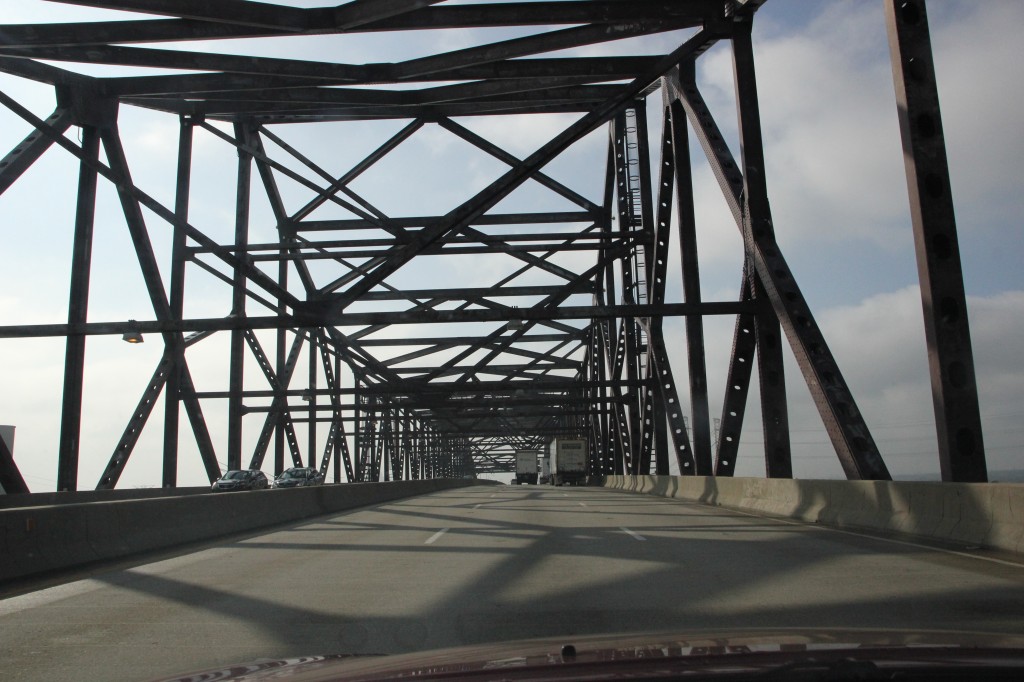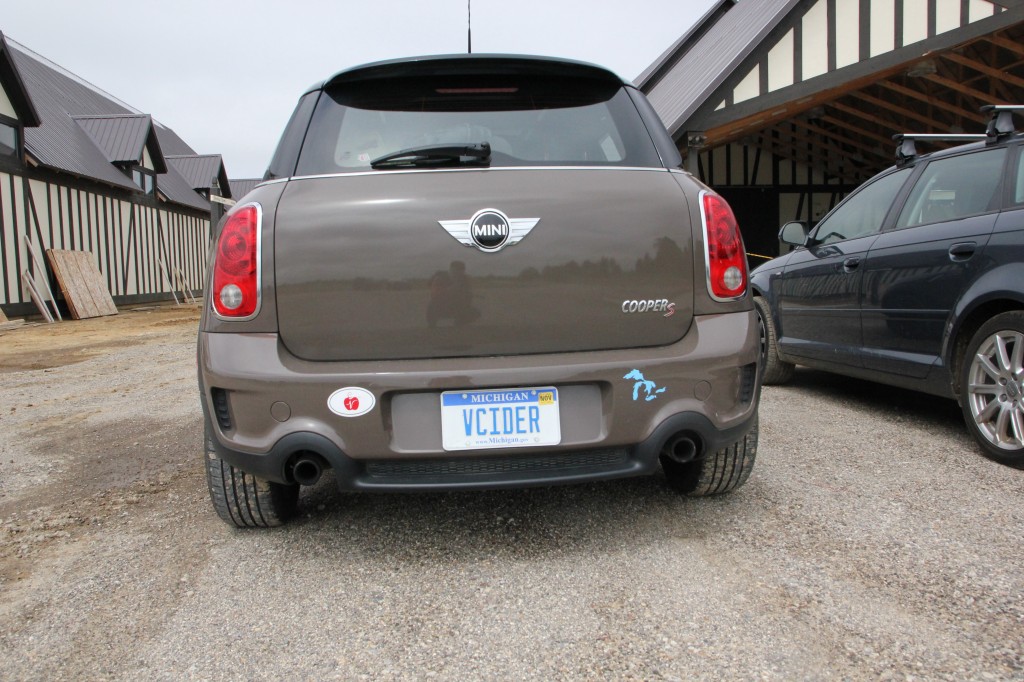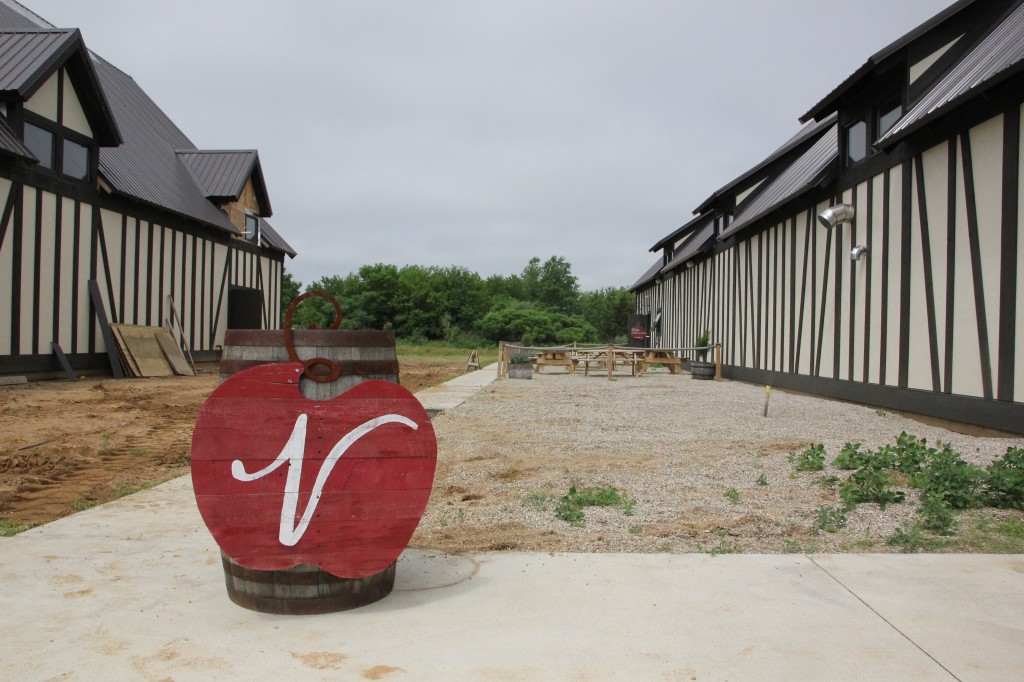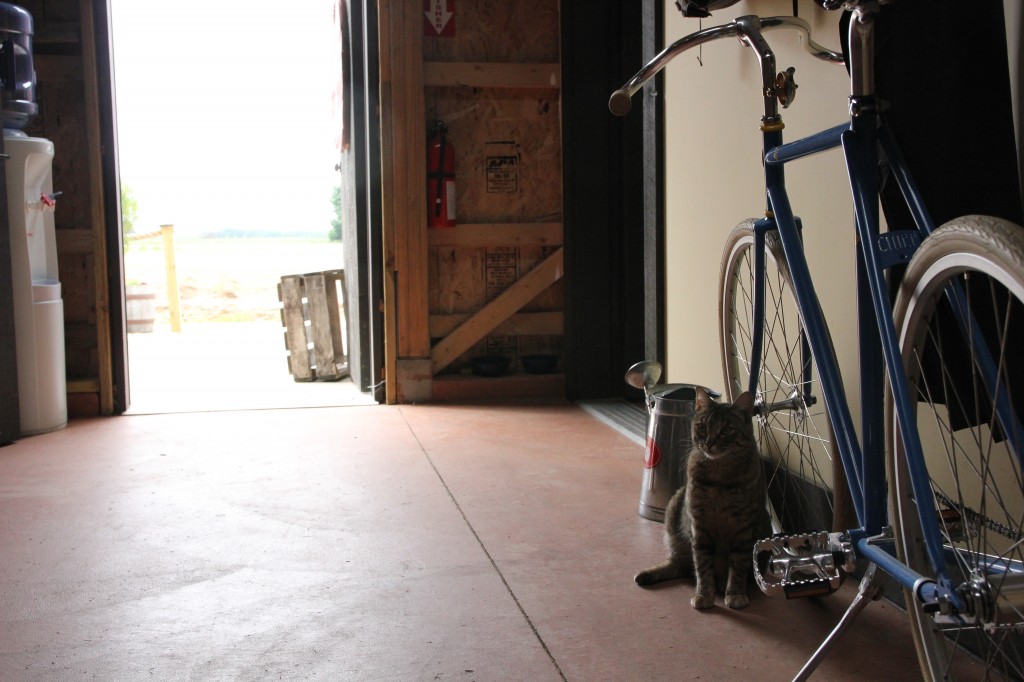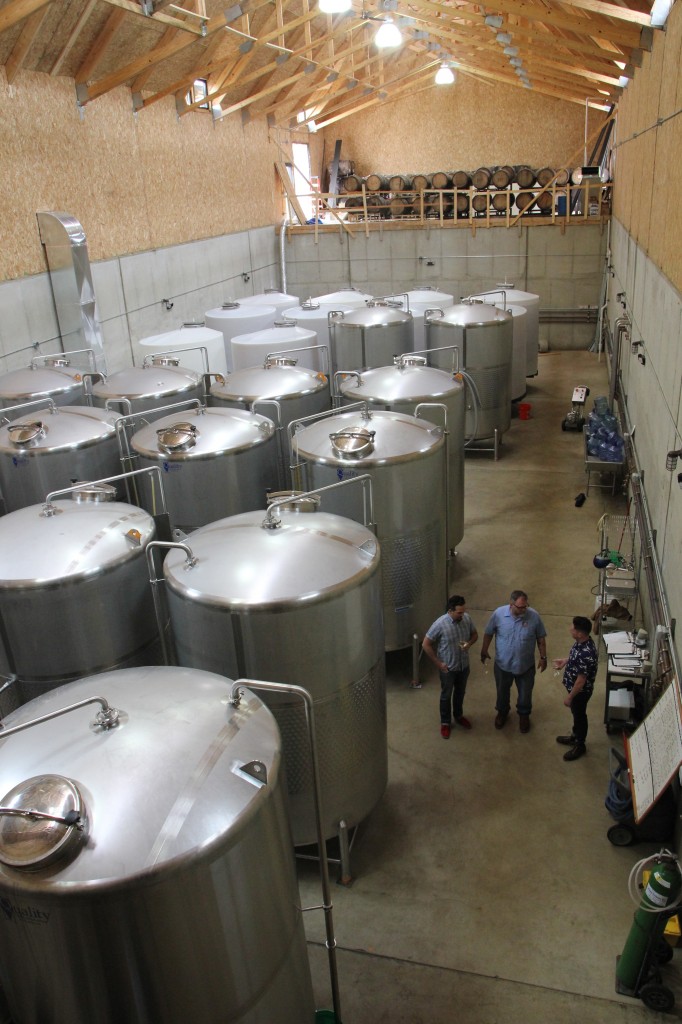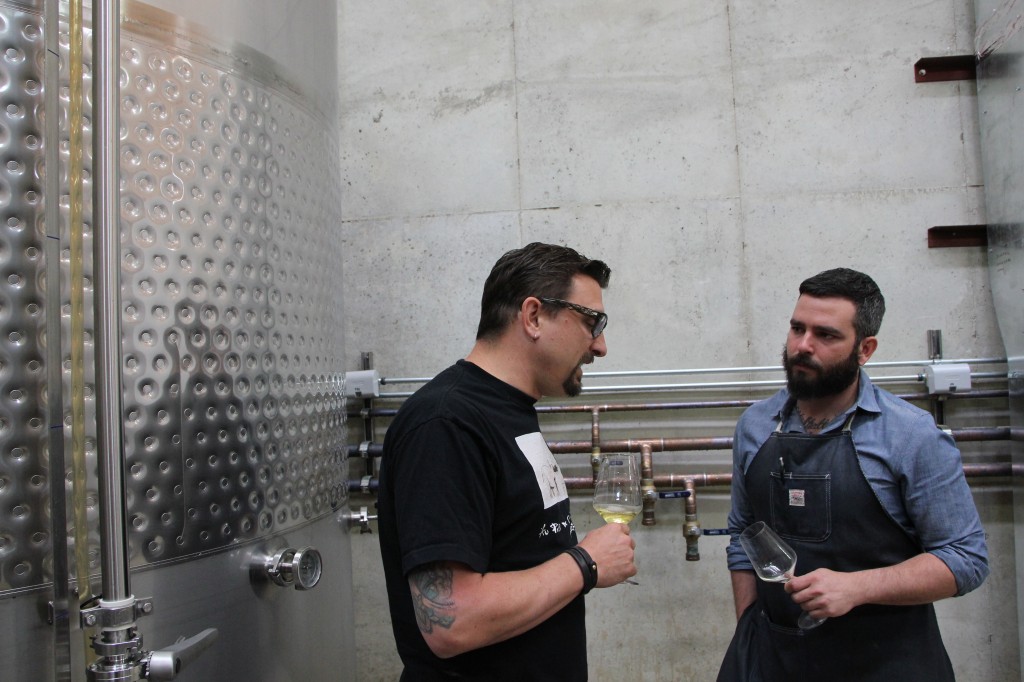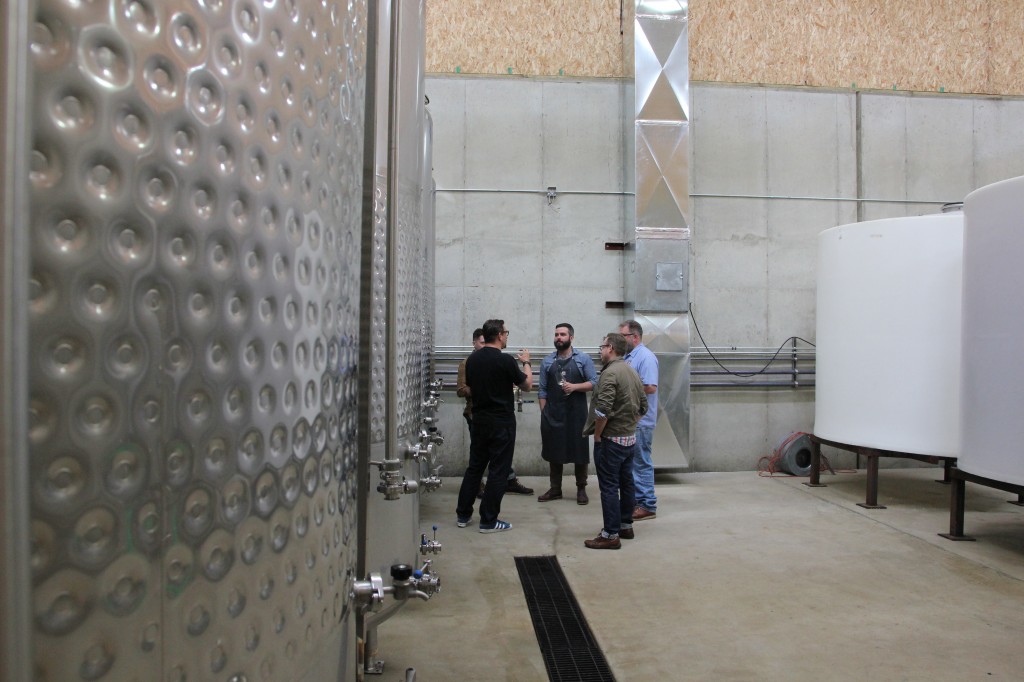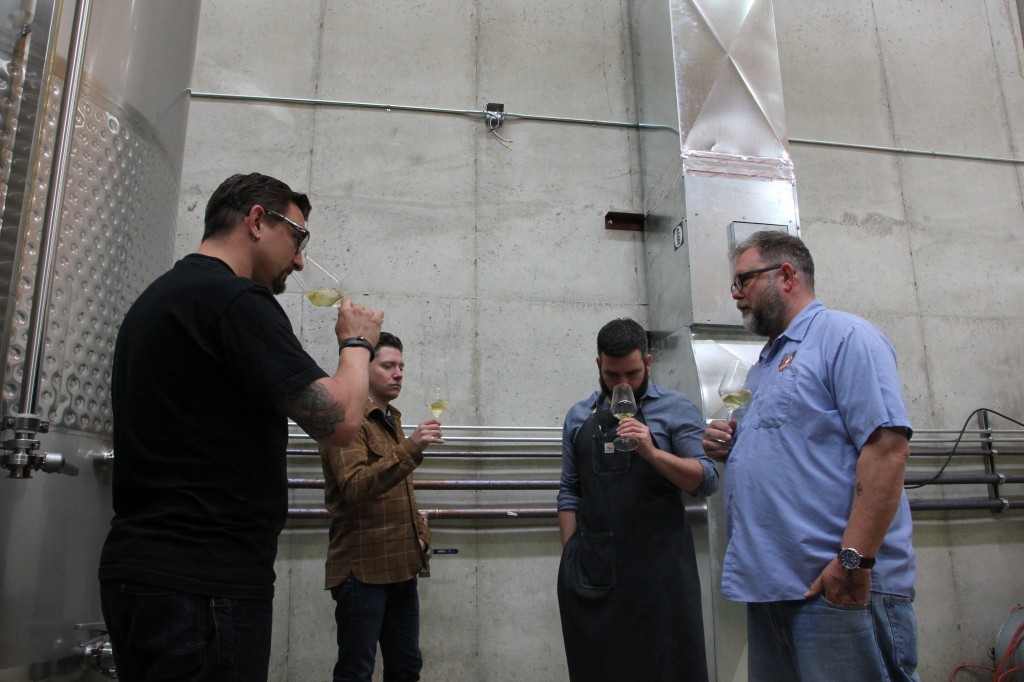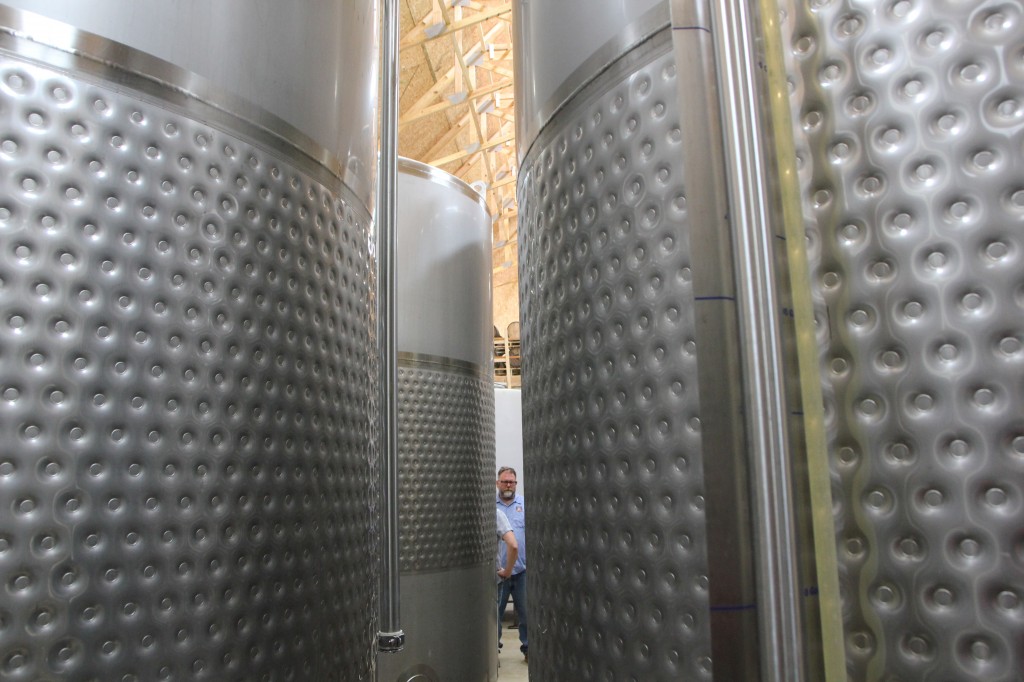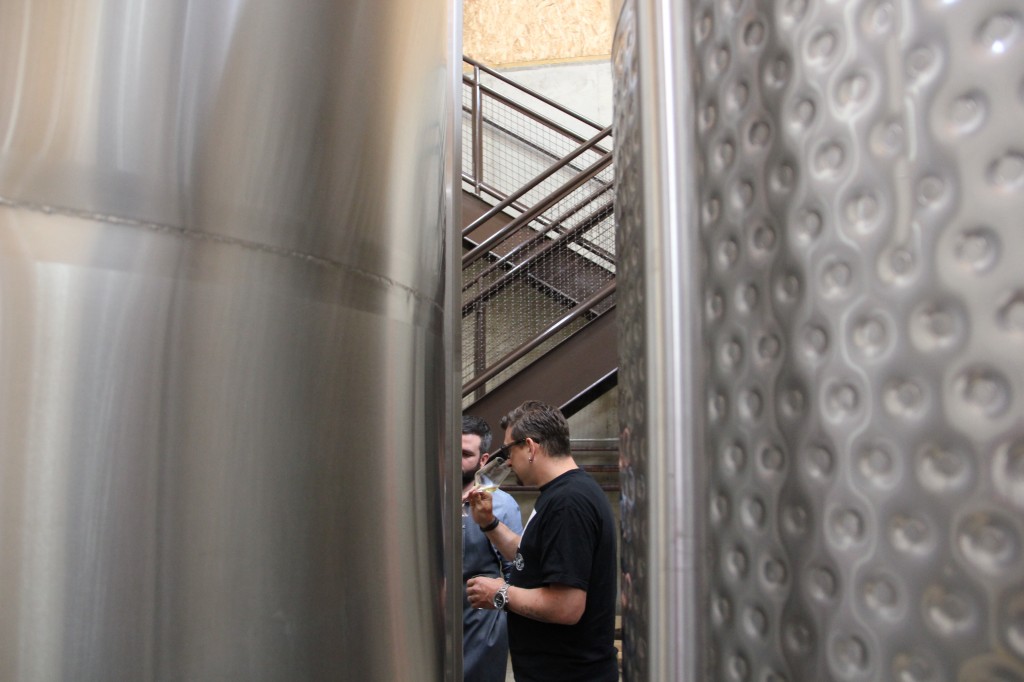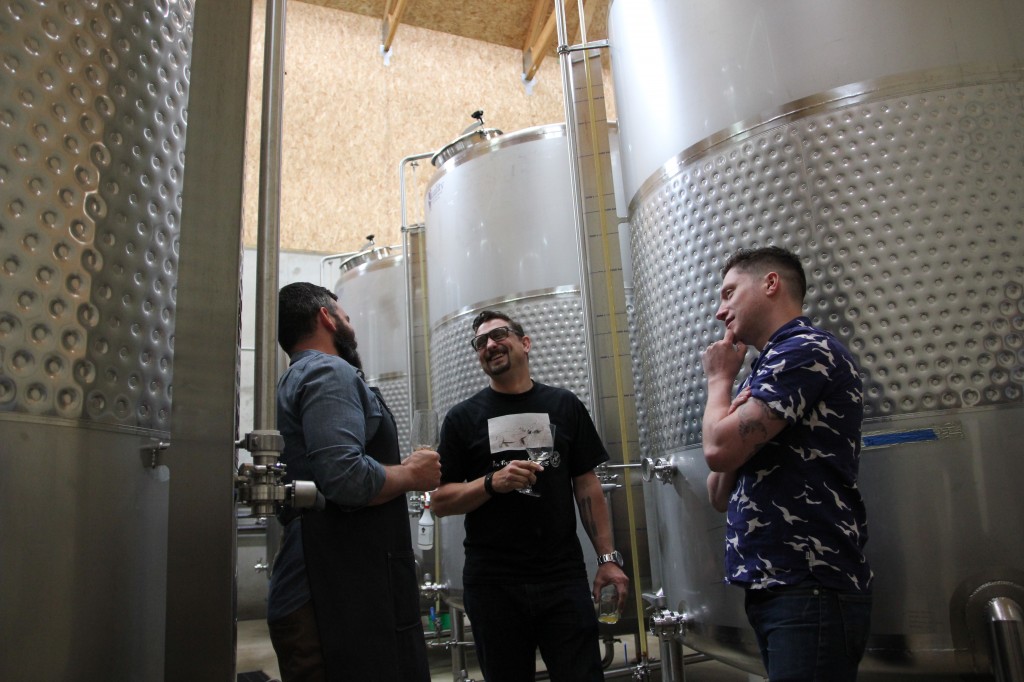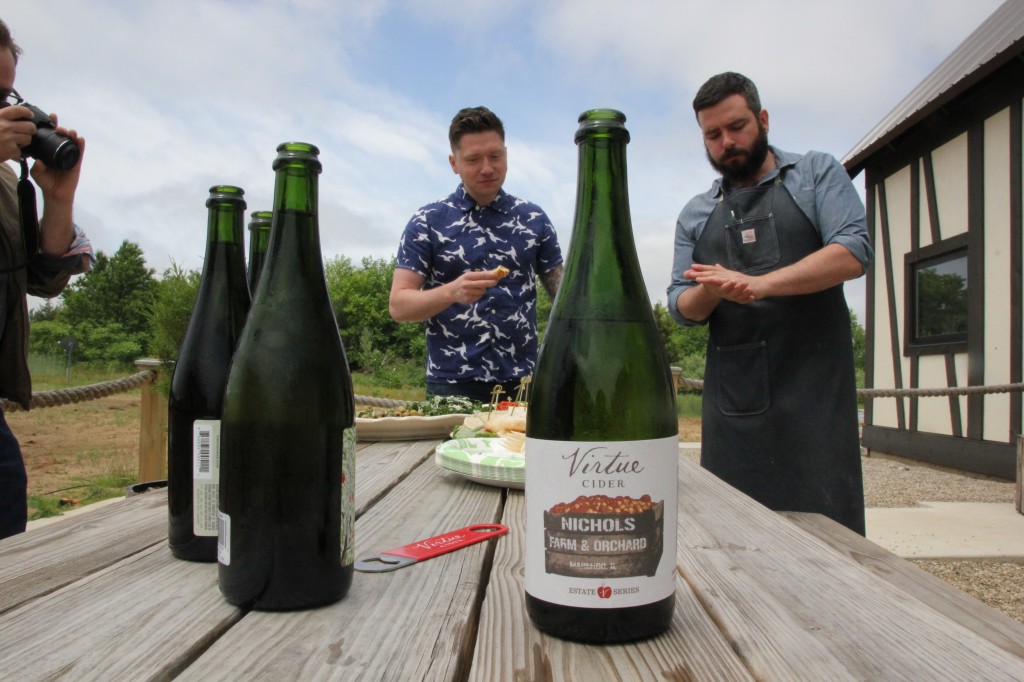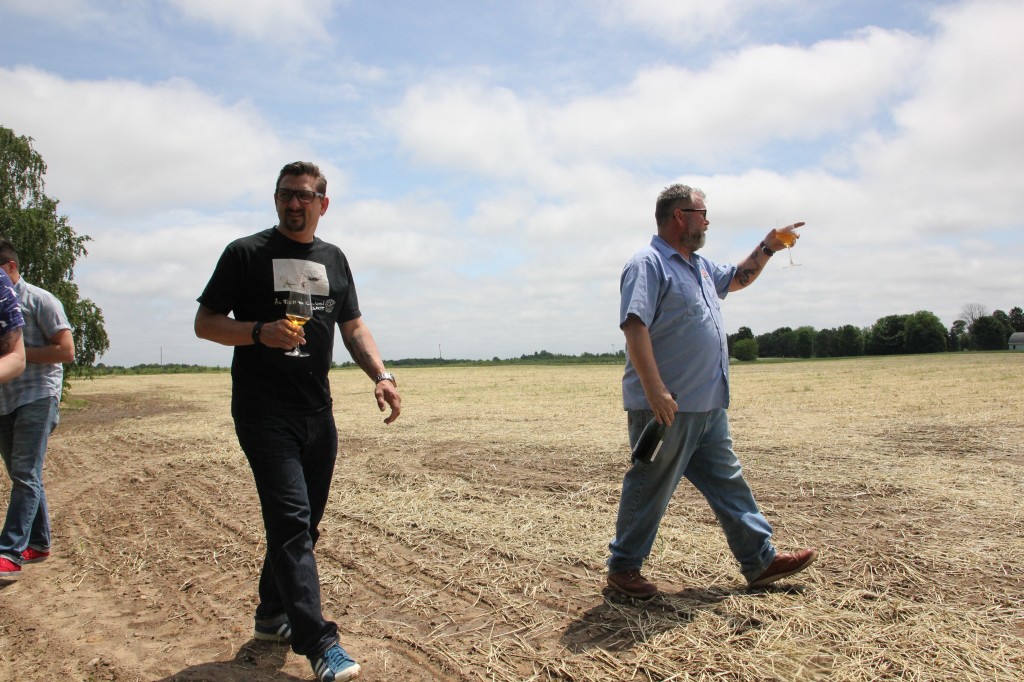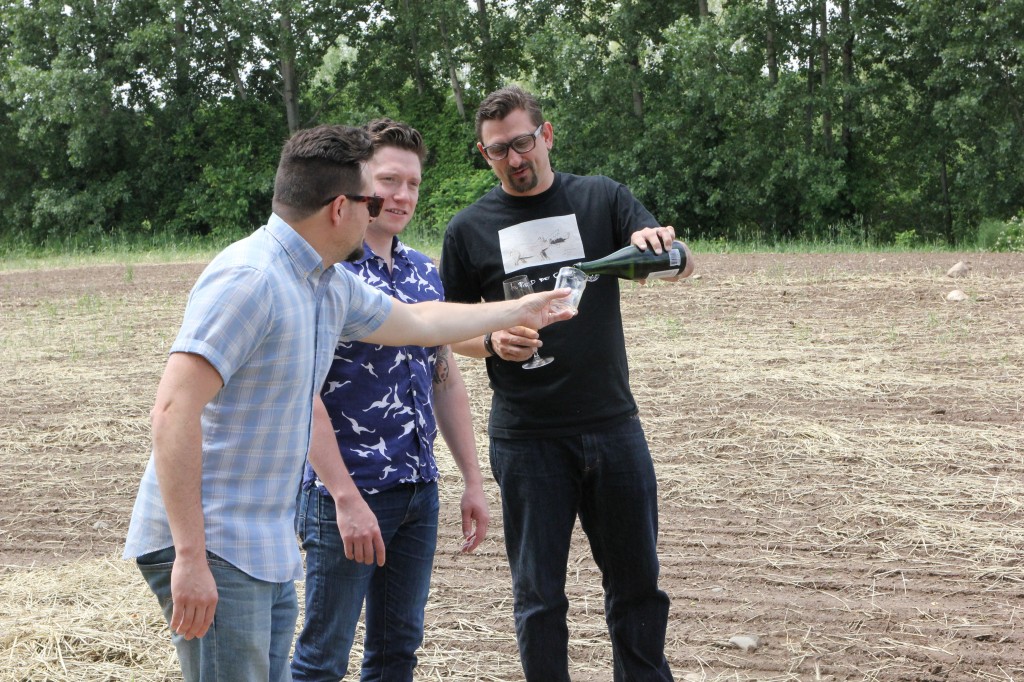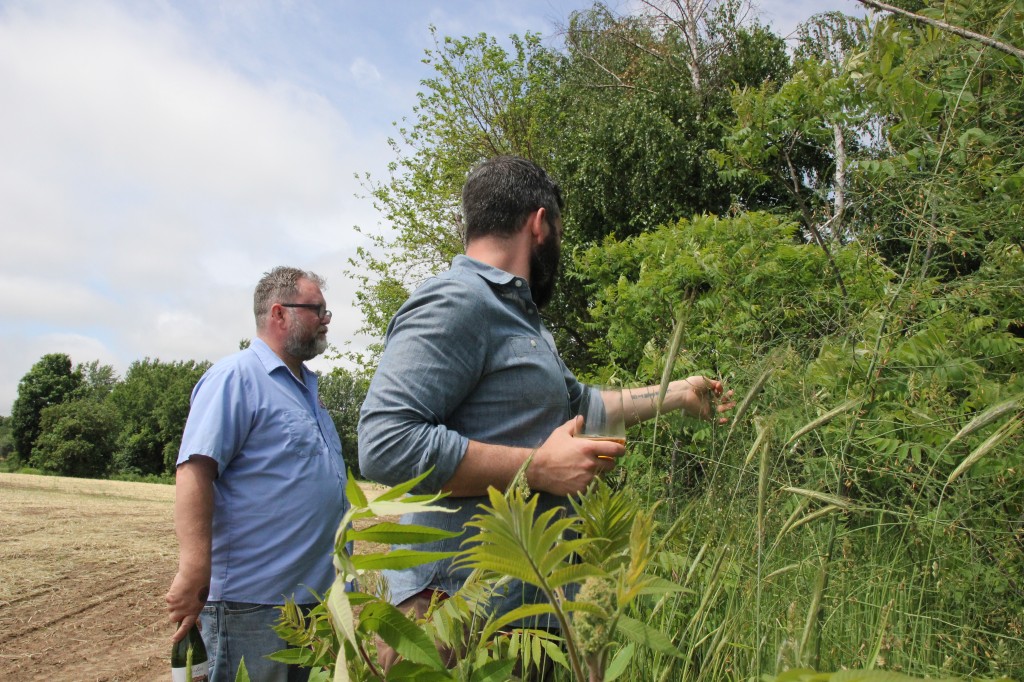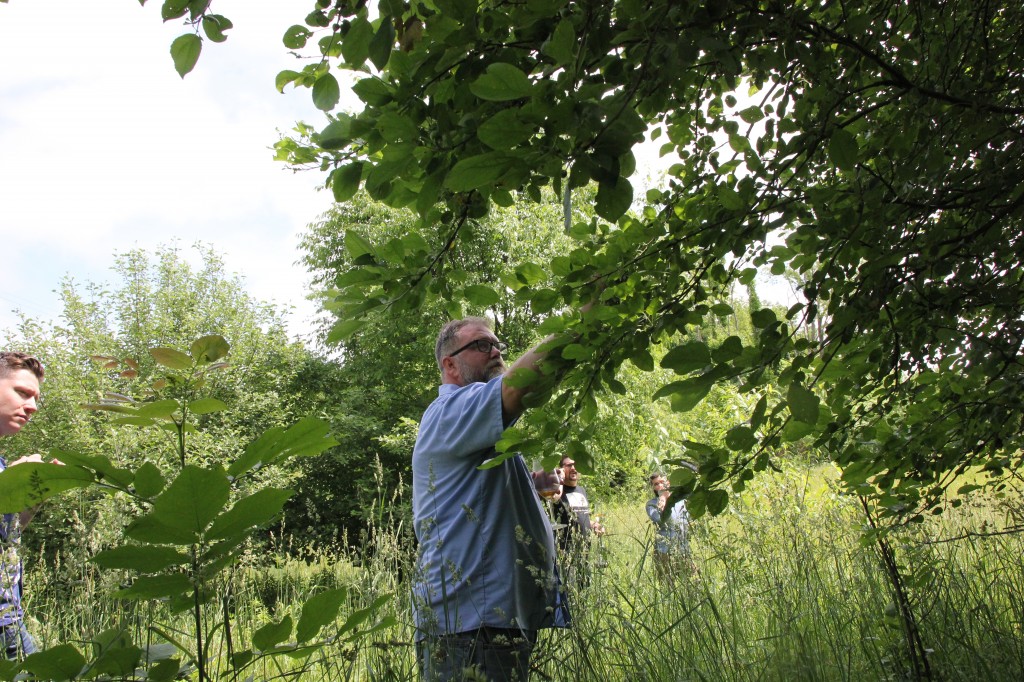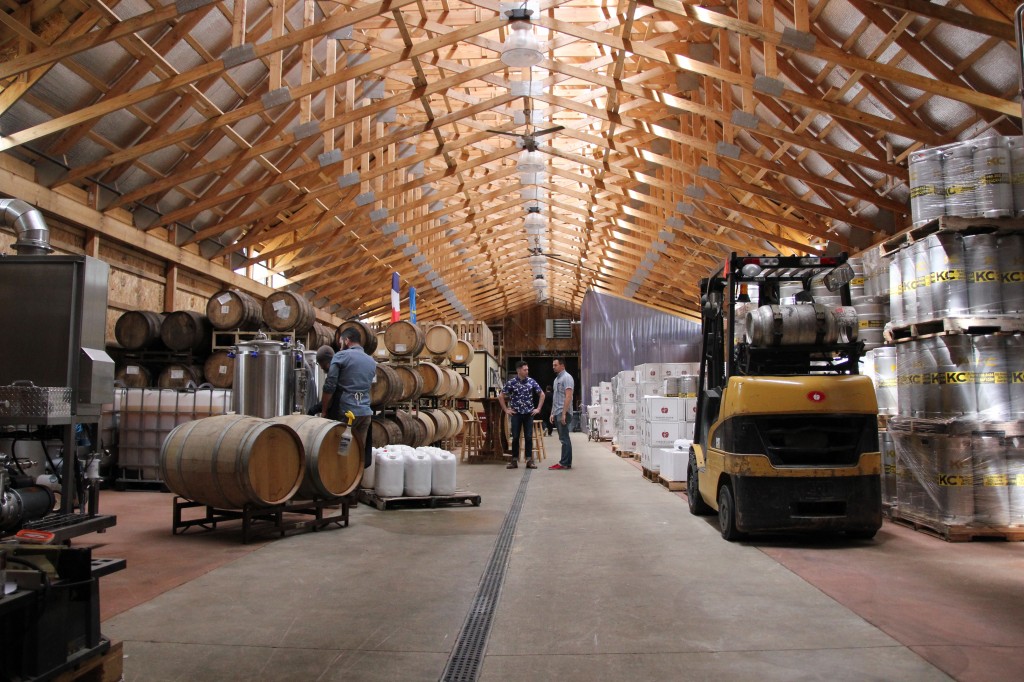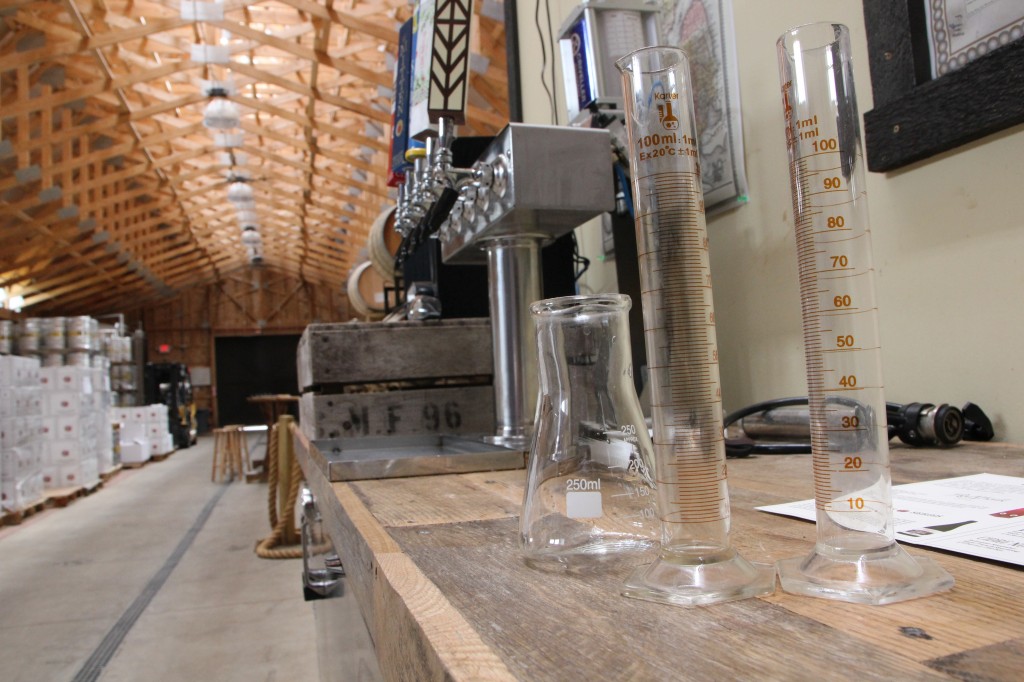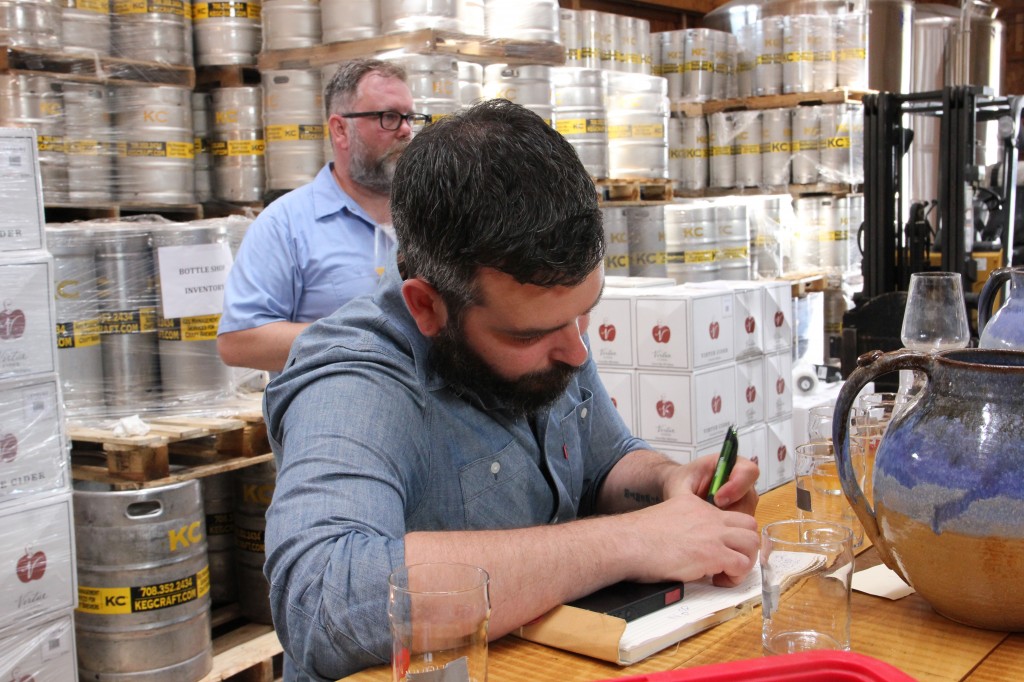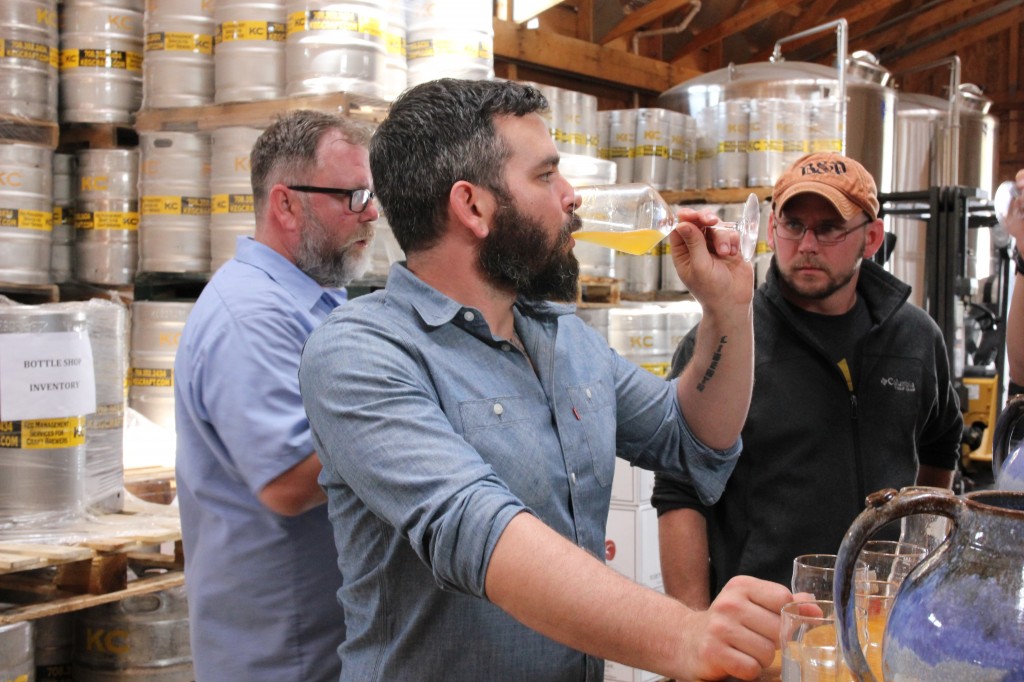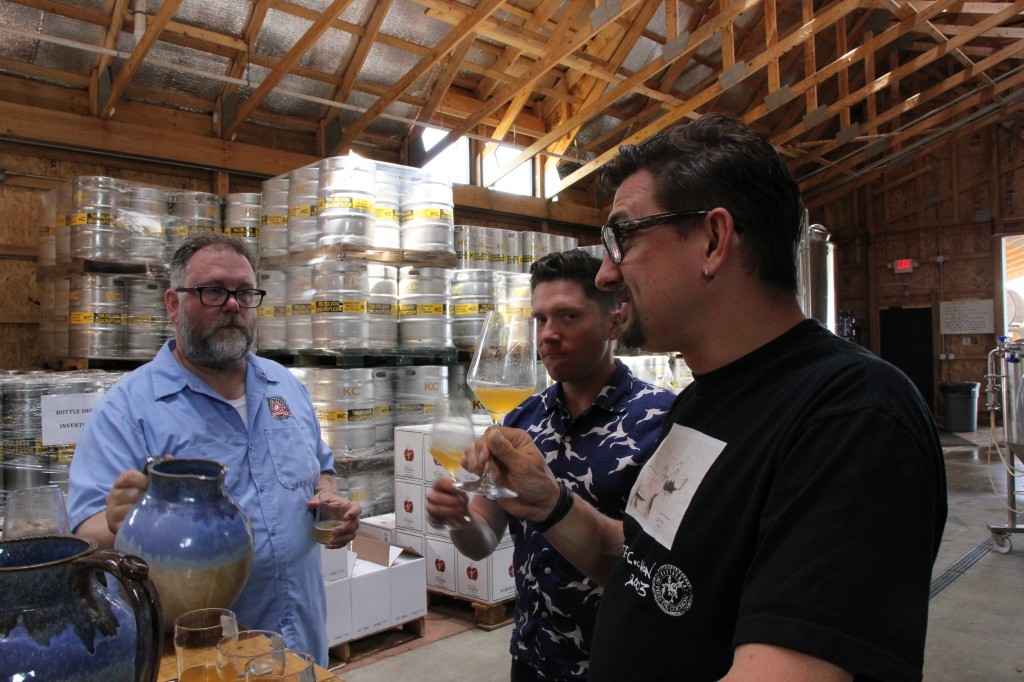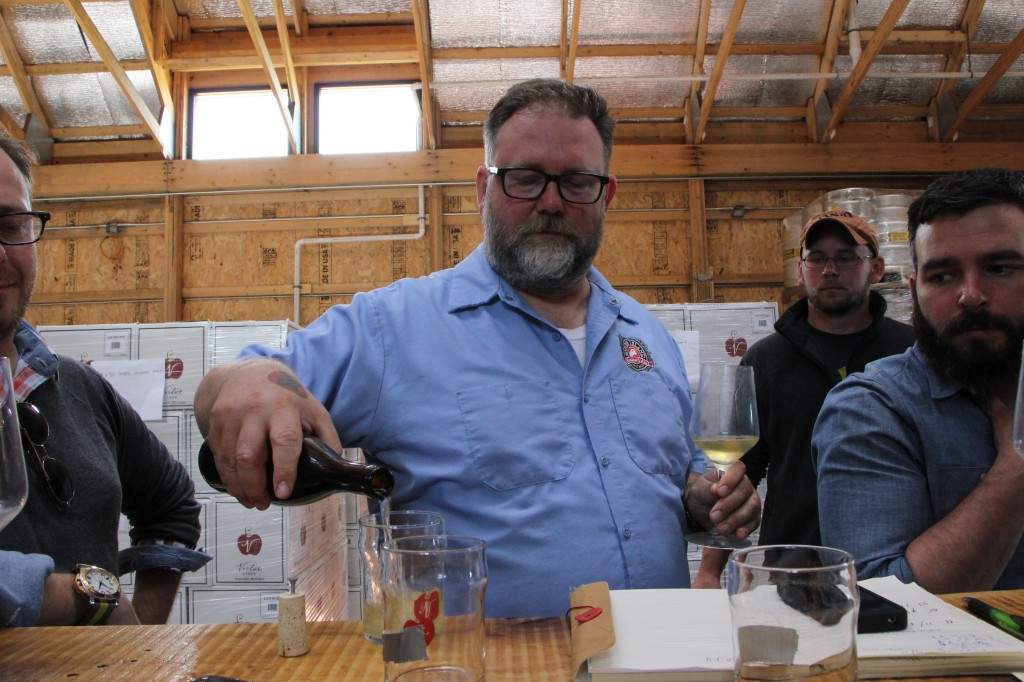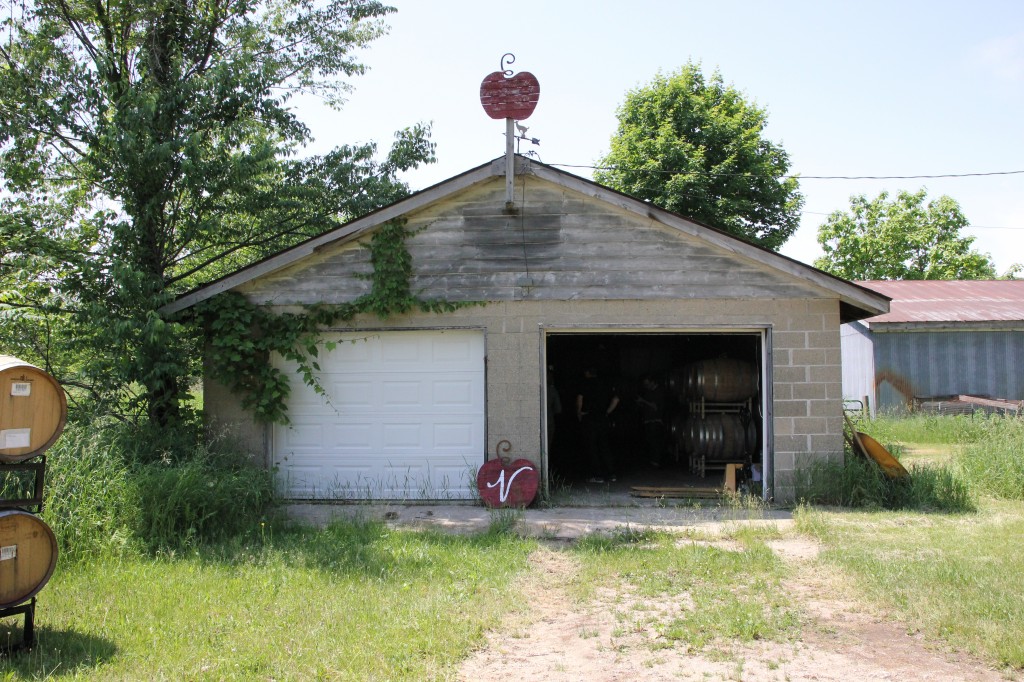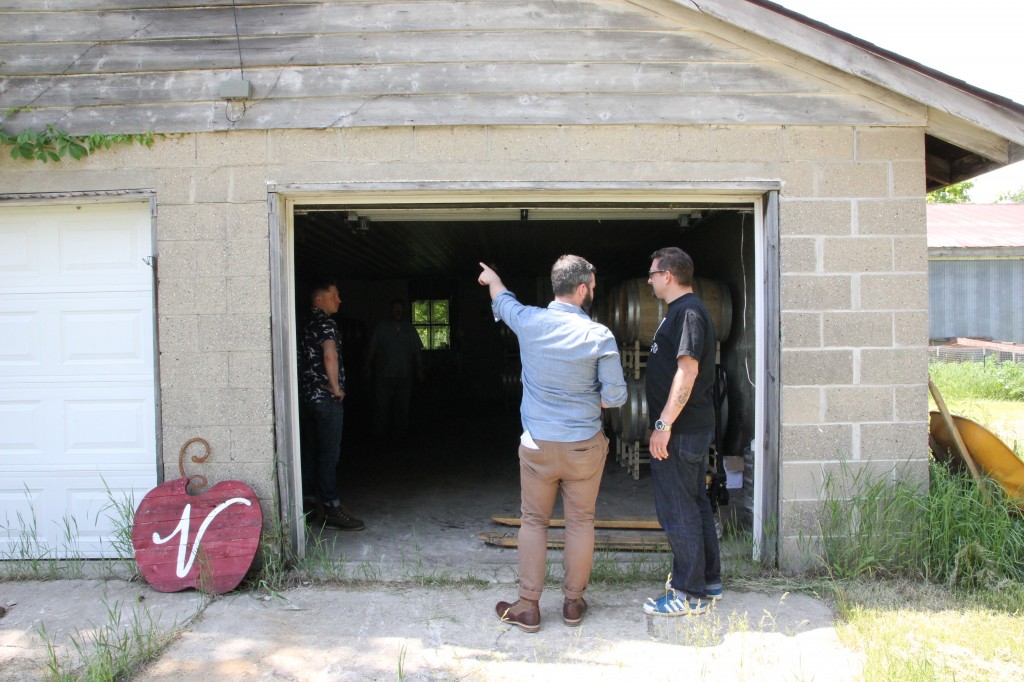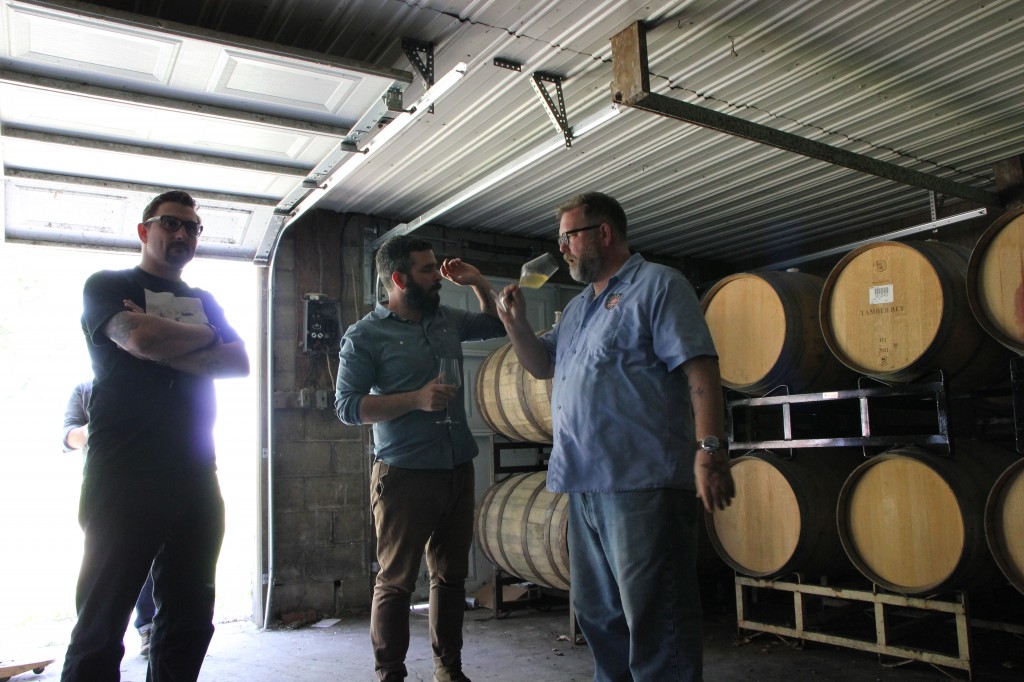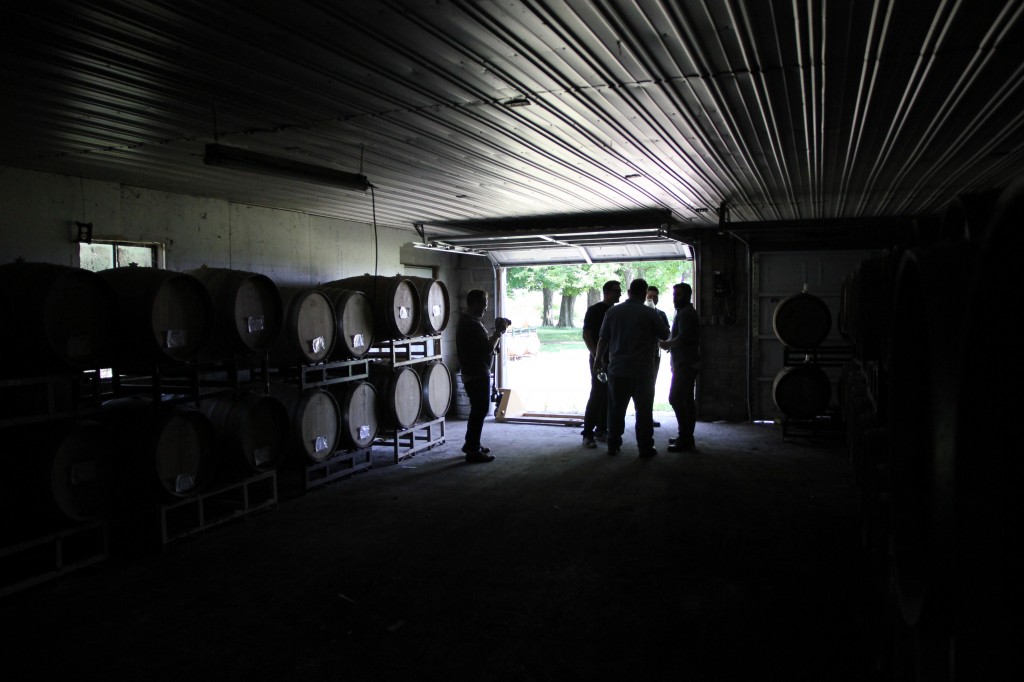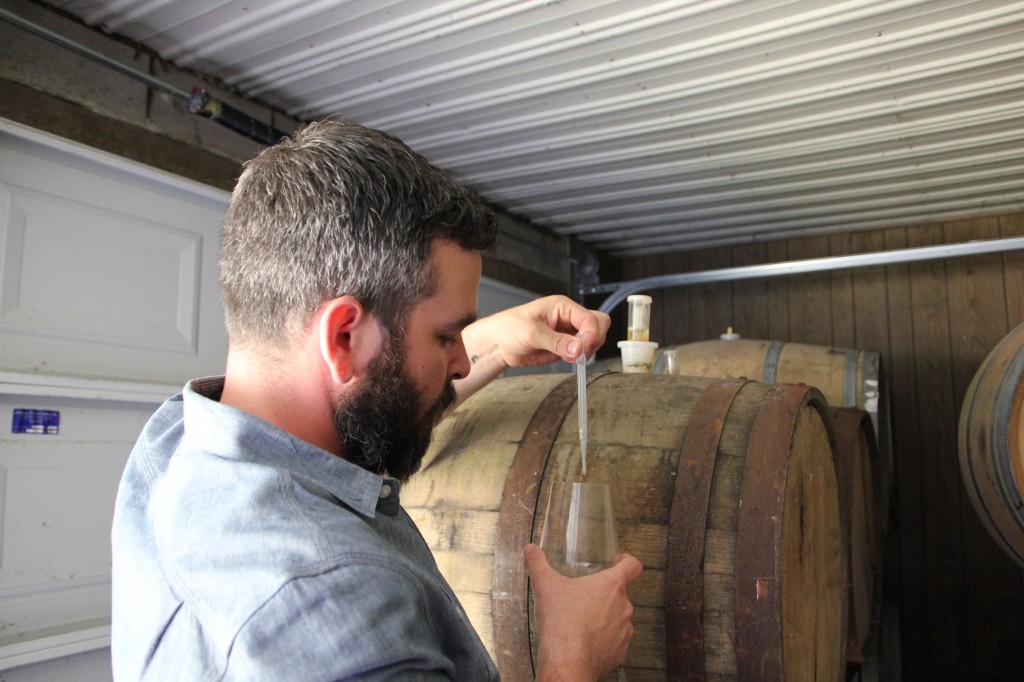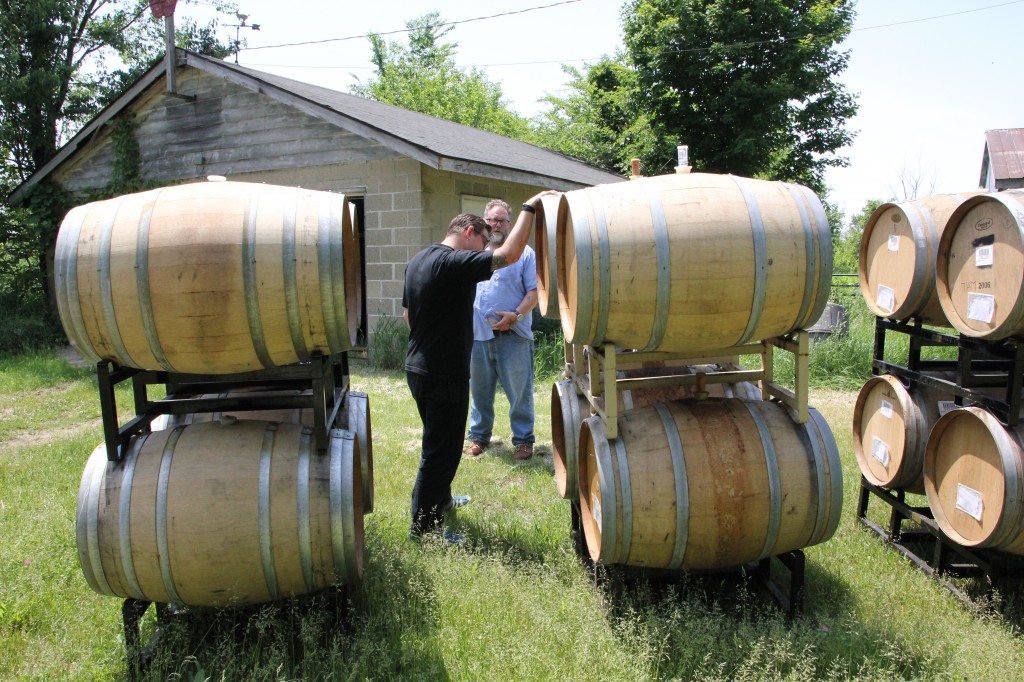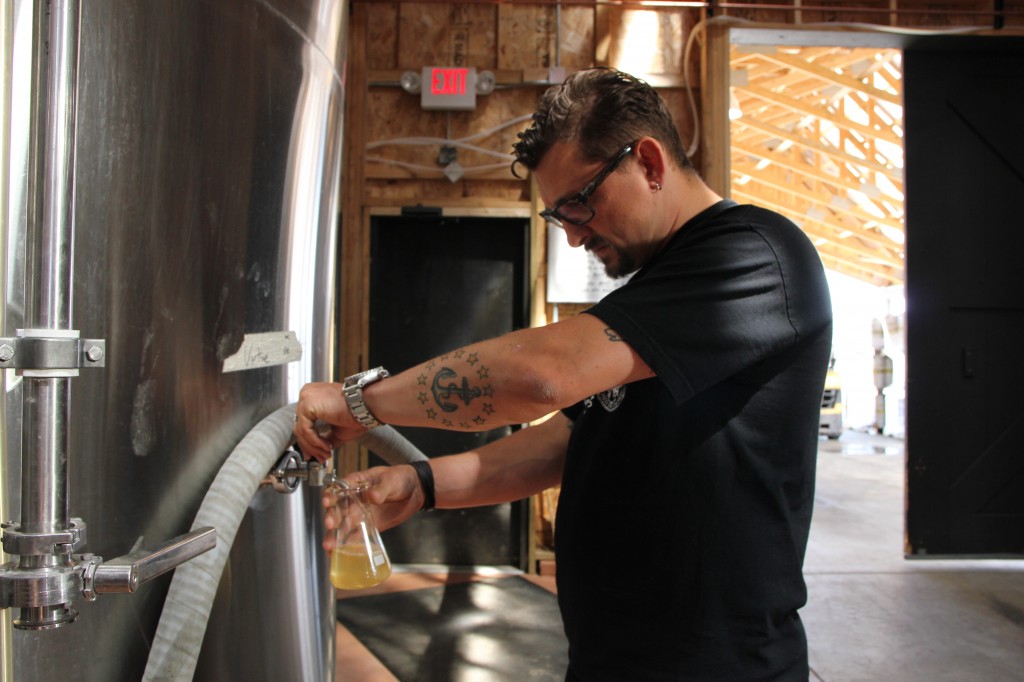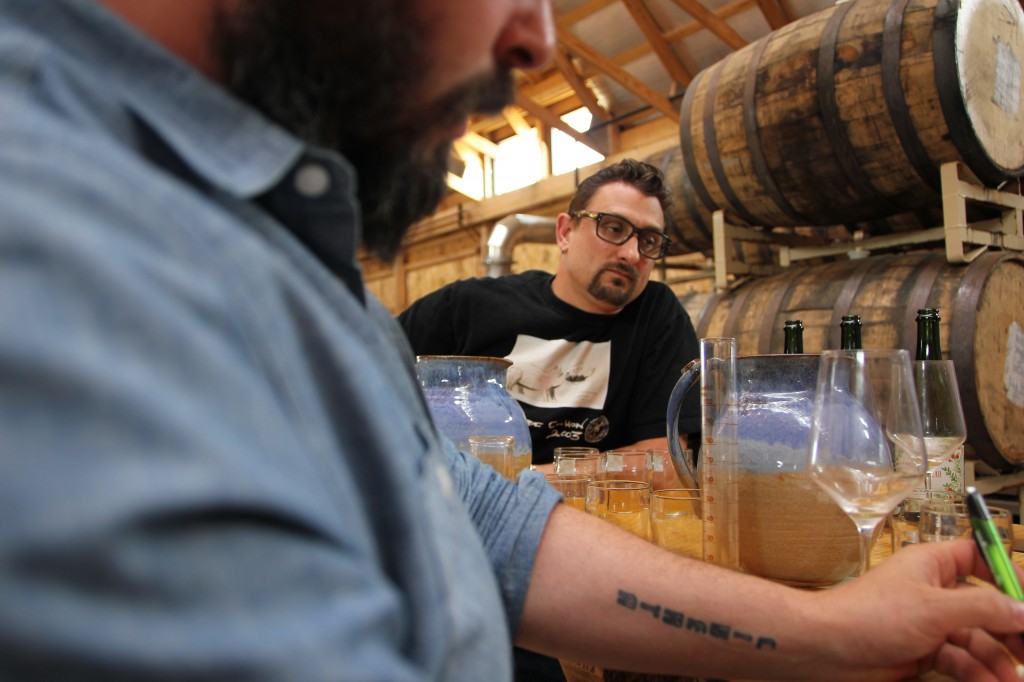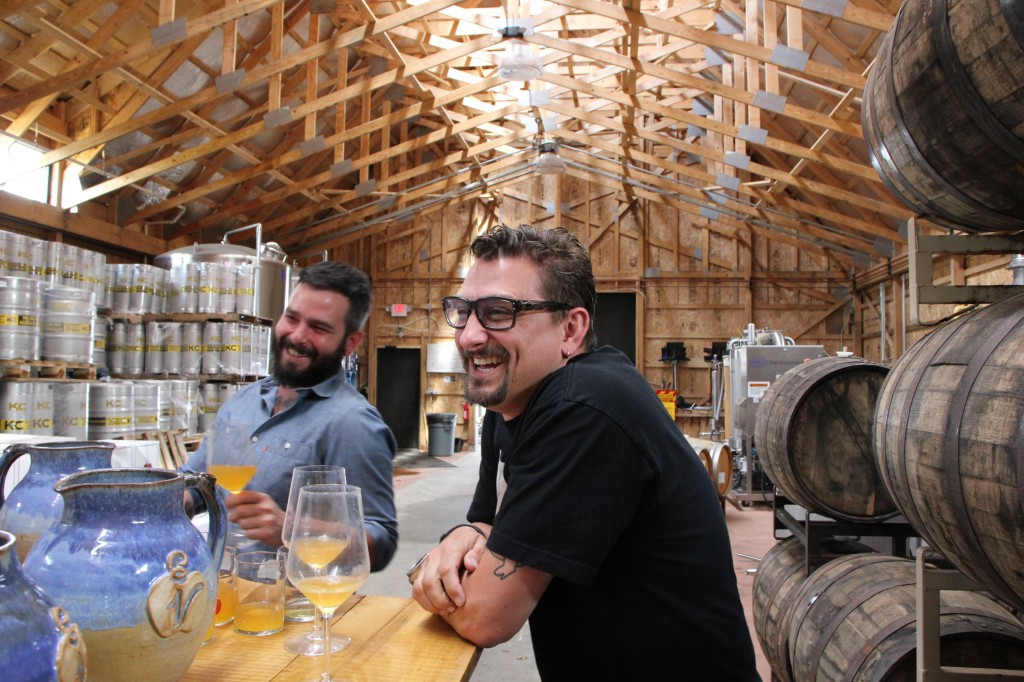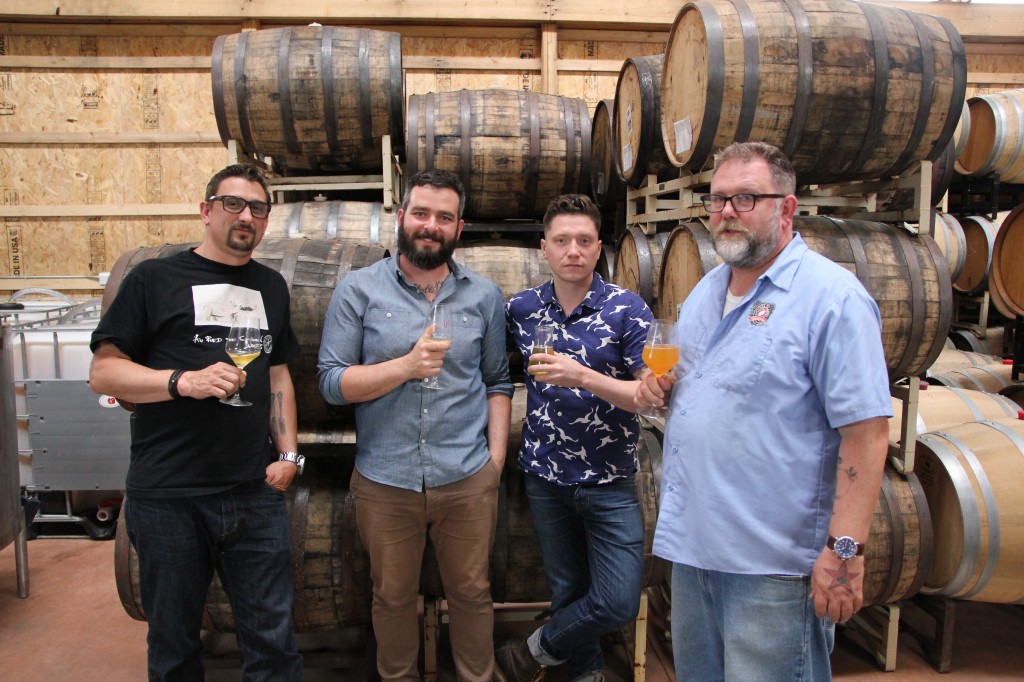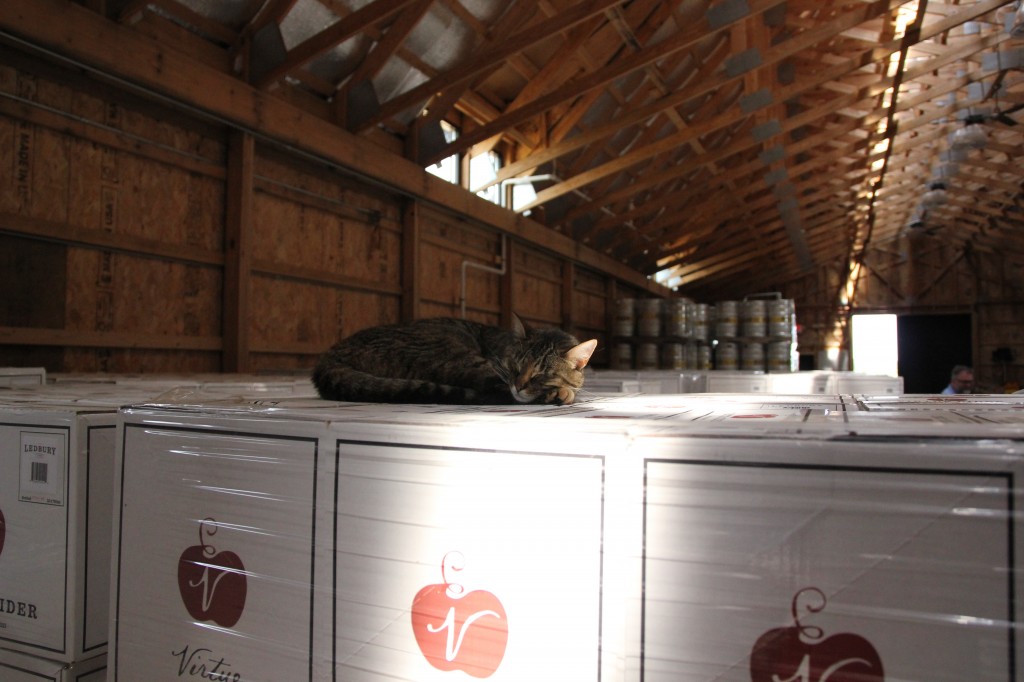It’s 7:30 in the morning and I’m drinking gas station coffee while flying down the highway and cursing myself for the now-empty bag of Taco Bell’s breakfast tacos greasing its way into my passenger seat. Despite this, spirits are high because I’m heading to Virtue Farms for a unique blending session with Virtue’s Cidermaster Ryan Burk and Chef Chris Consentino. No amount of bad breakfast decisions can take that away from me.
Chef Chris Cosentino, winner of Top Chef Masters, is known for his incredibly unique nose-to-tail cooking and offal dishes. He’s adventurous and award-winning with, as his website claims, “meat as his muse.” Today he’s visiting the farm to work with Ryan and the Virtue Cider team to construct a beverage with food and flavor in mind. By the end of the day, he’ll have created a custom cider to complement his unique cooking.
Virtue Cider’s Virtue Farms
When I finally get off the highway and drive through the tiny town of Fennville, I arrive at Virtue’s beautiful farmhouse cidery. There’s a dark tan Mini Cooper with plates that read “VCIDER” in the gravel driveway and a cat lounging in the sun. I head inside, meet up with Joel, Virtue’s marketing director (and possibly the world’s friendliest human) and follow him to the cellar where the rest of the party is already gathered.
Step 1: Sampling the Ciders
Opening the door to Virtue’s massive cellar is like opening the door to Willy Wonka’s chocolate factory, only without the creepy Oompa-Loompas. And there’s no chocolate either.
What is there are rows and rows of massive cider-filled tanks. It’s awe-inspiring.
Owner Greg Hall, Cidermaster Ryan Burk and Chef Chris Consentino are already hard at work. I approach the group.
“Hi, I’m Bobby Flay.” A hand shoots out to greet me and I’m taken aback by “Bobby’s” friendliness.
“I’m Matt.”
The hearty laugh that follows will be a theme for the day. I tell Chris I’ll be following him with a camera all day and writing down everything he says. He doesn’t seem the least bit phased.
Ryan and Chris walk from tank to tank, pulling samples from their faucets. They swirl their glasses, hold them to the light, take deeps sniffs and discuss. They get real nerdy.
“I like things that are crisp and refreshing” Chef Chris says when I ask him what he’s looking for in a cider. “I want things that accentuate food.”
The group is tasting a wide range of Virtue’s ciders in a variety of stages – blended and unblended, fermented and fresh, dry and sweet. They’re looking for flavors that stand out so they can identify a few “base ciders” to be used in the afternoon’s blending sessions. It quickly becomes clear that even though Chef Chris has a famously sensitive and developed palate, this is not going to be an easy task.
There is more tasting.
Step 2: Break for Lunch
When Joel shows up with a platter of sandwiches from Farmhouse Deli down the street, everyone agrees that their palates could use a change of scenery. A few bottles of Virtue’s favorites are broken out and we eat on a picnic table out back that overlooks the farm. A bit of Percheron, Cidre Nouveau, Sidra de Nava and the first in Virtue’s Orchard Series, Nichols Farm, does well to relax the group. The farm-fresh meat and salad doesn’t hurt either.
Next, we embark on a tour of the estate.
Greg Hall leads the tour, bottle in hand, and talks us through his ambitious plans for Virtue Farms. Greg dreams big. He tells us of a future apple orchard, cider classes, and even a bike trail for local cyclo-cross riders. He also tells us about the properties’ history.
More cider is poured. It’s hot outside. We walk through fields and hike through trees. We learn about the history of the land – it used to be an orchard years ago, and the farmhouse that currently serves as a residence for Virtue’s cider makers was originally built in 1866. Greg points out several old heirloom apple trees that still bare fruit and tells us of his commitment to bringing the old orchard back to life to eventually be used for cider making.
More cider is poured. It’s still hot. We pass what someone jokingly refers to as Virtue Pond, but is more of a large puddle.
More cider is poured. We go back inside the cider house.
Step 3: Initial Blending Session
Everyone gathers around the sampling table for the first blending session. Ryan and his team bring out jugs of Chris’ favorite base ciders from the tanks, each labeled with a different letter. This is where the art (or maybe science) begins.
There are beakers and notebooks and percentages and ratios. Occasionally, fingers are waved over batches, someone cackles “toil, toil” and laughs ripple around the circle.
Then we drink (some more).
We try base cider A blended with base cider B. It’s a bit flat. We try base cider A blended with a lower percentage of base cider B. Still not quite right. We try base cider A blended with an even lower percentage of base cider B and a touch of base cider C. Maybe base cider A isn’t the right choice.
And on and on, variation after variation, blend after blend in search of the perfect mix of flavor, mouth feel, and aromas. To the average drinker, the differences would have muddled long ago (and I confess, to me they had) but to the men sitting in front of me even the tiniest change is noticed, noted and discussed. It’s a testament to their highly refined palates.
We break again.
Step 4: Take a Break, Tour the Barrel Room
A short walk back towards Virtue Pond reveals a small parking garage and a couple wooden casks set out in the sun. Ryan pulls the garage door open and we’re greeted with a blast of that deep, musky smell that accompanies a room full of wooden casks. Heavenly.
This is where they keep the Brett (Brettanomyces) infected barrels for the aging of various ciders, including Lapinette. This is where they keep “the good stuff.”
Ryan pulls a sample of a wild fermented portion of Percheron. Chris makes sure he points out the bung.
I get a picture.
“Bung” jokes are passed around.
We leave the garage and head over to the casks where a batch with yeast from a popular brewery has been fermenting. Greg pulls a sample and everyone agrees it’s as good as, if not better than, the beer that brewery uses the yeast for.
I ask Chris for his thoughts on Virtue Cider and their operation.
“I knew the quality that was here but now that I’ve walked through the property and seen everything it’s even more like holy shit… there’s no hiding behind anything, there’s no extra bullshit in here like sugars or artificial anything… it’s just straight up real product. They take the same mentality about ciders as I take every day when I go to farmers markets or work with food and I want to be able to work with people that think like that.”
The respect is mutual, it seems, as Ryan gets into his thoughts on having Chris at the farm:
“It’s unreal to have Chris Cosentino here because he has such an expansive palate. He’s done so much with food and he’s trying things in the kitchen that no one has the guts to do – I mean, then he takes those guts and puts them in his food – It’s amazing, the guy’s doing head to tail cooking. He’s such an inspiration…his understanding of taste and aroma and what it takes to make a great food-forward cider.”
We stand in the field a bit longer, make dinner plans and head back to the tasting room. It’s time to make some decisions.
Step 5: Second Blending Session
With fresh palates, the cider tasters return to the bottle.
The earlier blending session resulted in eight different renditions that are recorded in the notes. Chris and Ryan revisit a few of them and Chris asks for Greg’s opinion.
“M (one of the base ciders) has got all this nice minerality, it’s a more austere cider. I think you want to use M as a base” he says.
We try some more blends, focusing on M as a base. Someone returns to the tanks to pull more ciders.
We drink, we talk, we measure, we drink, we talk and finally a decision is made: Chris likes cider M.
Not a blend, just cider M.
“There’s really no need to blend because the unfiltered cider that we found downstairs is perfect as is” he says. “It really doesn’t need anything – mixing in and pulling things out, it just didn’t have the same pop and aroma and the fruit wasn’t coming through…it’s completely unlike anything else and I think that, to me, is what’s so exciting about it.”
Now that a decision has been made, the next step is to bring the cider to dinner and see how it stands up against food. This is the real test. Chris wants to know how it works with fats, how it will work with acids on the table. How will it accentuate the food?
As the group gets ready to head out to Reserve, a Grand Rapids favorite, I curse the fact that Chicago is hours away and I have to get back on the road. A bottle of cider is shoved in my hand, we shake hands and goodbyes are exchanged. I snap a few group photos and taste cider M one last time. I say goodbye to the cat.
It was crazy, yes. There was a lot of cider. But when you’re lucky enough to get to witness two people who are experts at their craft come together and create something new, you just try and get out of the way to watch it happen.
And take a lot of pictures.
// Matt Tanaka
EDIT: As it turns out, when cider M is paired with the food there (the charcuterie in particular), it becomes clear that a bittersweet, wild fermented component would give the cider an added complexity. Because the cider is meant to pair well with food, they decide to blend Cider M once more, proving that the creative process is never really complete.
Next week on the Lakeshore Beverage Beer Blog: We taste the results of Chef Chris Cosentino’s Virtue Cider collaboration, Offalgood Cider! Subscribe to our email newsletter list below to be notified of our posts:


